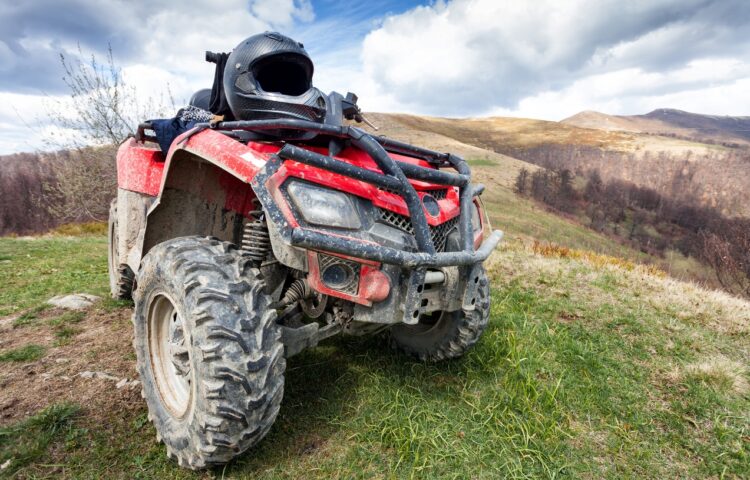Summer is full of opportunity and adventure for kids who like the outdoors. All-terrain vehicles (ATVs) are exciting and many kids can’t wait to get off-road and try them out. Although these vehicles may seem like a fun summer activity, they can lead to some serious – even fatal – injuries, especially if you don’t follow ATV safety rules and regulations.
In fact, the American Academy of Pediatrics (AAP) recommends that children under 16 not ride ATVs at all. They say this age group lacks the necessary physical strength, coordination, and judgment to drive an ATV safely in all situations and conditions. Still, despite the risks, many kids are legally able to ride ATVs. Each state has different guidelines and laws about age requirements, many of which allow children under 16 to ride ATVs. But before you let your kiddos hop onto an ATV, know the risks and follow these ATV safety tips.
Risks
ATVs are built with a high center of gravity, and can easily tip over. Combine this with weights up to 850 pounds and driving speeds of 50–85 miles per hour, and a fun drive in the woods can easily become a disaster. To make matters worse, ATVs have no roll bars, safety cages, or seatbelts to offer extra protection. Following some safety tips while driving one of these vehicles could help you avoid any accidents on your part. Nevertheless, it’s not a bad idea to have an attorney who is an expert in personal injury law on retainer for you, as external incidents are out of our control and it’s better to be safe than sorry!
Injuries sustained from ATV accidents are often serious and can be life-threatening. Common injuries include:
- cuts and scrapes
- broken collarbones
- broken arms and legs
- abdominal trauma
- head and neck injuries
ATV Safety Tips
The only way to truly guarantee safety is to prevent your child from riding an ATV at all. But these safety tips can help lessen the risk of injury:
1. Wear the correct clothing and protective equipment.
Avoid shorts and tank tops, which leave a lot of skin vulnerable to cuts and scrapes. Instead, riders should wear long pants, long sleeves, gloves, and over-the-ankle boots. Safety equipment can also determine the severity of injury in an accident. Riders of all ages should always wear a helmet and eye protection. Plus, your state law might require this anyway. It may be worth wearing clothing that is inflammable and also face coverings are essential because, as with any fuel-powered machine, there is always a fire safety concern present. This is why the ATV center that you’re either training or riding on should have fire extinguishers to hand, should the unthinkable occur. Check out the range of fire extinguishers over on the Seton website along with their first aid kits to help in the event of injury.
2. Participate in an ATV safety training course.
These courses teach kids how to safely ride an ATV in different circumstances. Training teaches the necessary skills to handle the different obstacles that kids can encounter while riding off-road. These courses can be taken through the ATV Safety Institute or by contacting the National 4-H Council, local ATV rider groups, state agencies, and some ATV manufactures.
3. Ride an ATV that’s right for your size and age.
There are ATV models “for children.” These are smaller and usually include a mechanism to limit the ATV’s speed. Make sure your kids are riding ATVs made for their size and age. This helps ensure that they’ll be in better control of the vehicle and won’t reach dangerous speeds. ATVs should include a label or sticker that recommends the appropriate age of rider for that model.
4. Never ride with a passenger or be a passenger.
If the ATV is manufactured for one person, having a passenger can interfere with the driver’s ability to control the vehicle. The corresponding fall, roll, or crash can cause serious or even fatal injury. Even when an ATV is designed for more than one passenger, it’s still not a good idea for multiple kids to ride on it.
5. Never drive an ATV under the influence of alcohol or drugs.
No vehicle, including an ATV, should be operated while under the influence of alcohol or drugs. Drugs and alcohol interfere with the senses, slow down reflexes, and impair judgment, which are essential to safely operate an ATV. Riding an ATV often includes making quick judgment calls about whether to slow down, shift weight, and change course. Drugs and alcohol can interfere with a driver’s ability to make rapid, responsible decisions.
6. Only ride during the daylight hours.
Maneuvering over uneven terrain is difficult enough during the daytime. Seeing an unexpected bump ahead, a driver might slow down or steer around it. But at night, you’re less likely to see potential obstacles. This increases the chances of accidents.
7. Keep ATVs off of paved roads.
ATVs aren’t designed to be driven on paved roads – they’re meant for off-road or dirt-road terrain. Driving ATVs on a paved surface can make them harder to control. Paved roads also carry the risk of collisions with pedestrians and other cars or vehicles.
Although riding an ATV carries a lot of risk, following these tips can help to prevent accidents and injuries.



